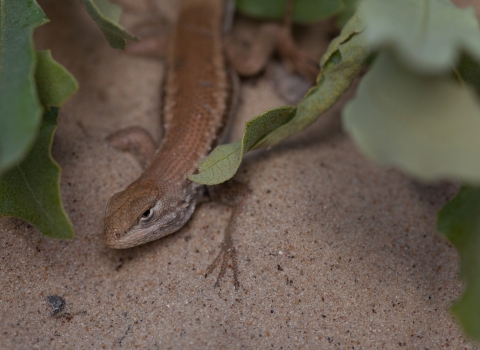Cambridge, MD - The Chesapeake Bay Nutria Eradication Project (CBNEP) announced at an event at Blackwater National Wildlife Refuge today that Maryland is now free of the exotic, invasive nutria.
The U.S. Fish and Wildlife Service (USFWS), U.S. Department of Agriculture’s Wildlife Services (WS), and Maryland Department of Natural Resources (DNR) have worked more than 20 years to make this difficult task -- never accomplished before on this scale -- a success.
Nutria were introduced to the Delmarva peninsula in Maryland from South America in the 1940s for the fur market. Since then, they have decimated thousands of acres of marshes with their destructive feeding habits, accelerated by the impacts of sea-level rise. Nowhere has this been more evident than Blackwater National Wildlife Refuge, which lost more than 5,000 acres of wetlands through a combination of nutria impacts, sea-level rise and land subsidence.
The impacted marshes provide critical habitat for migrating and wintering waterfowl, breeding areas for at-risk wildlife such as the saltmarsh sparrow, spawning grounds for commercial fisheries including striped bass and blue crab, and homes for threatened and endangered species such as the black rail. These wetlands also provide resiliency to coastal communities, protecting communities from increasingly intense storms.
“The Chesapeake Bay Nutria Eradication Project is an excellent example of foresight and collaboration,” said Service Director Martha Williams, who delivered remarks at today’s event. “This project is a powerful case study for how federal and state agencies can work closely together to achieve a shared goal that benefits the environment and the community.”
In 2004, the total annual economic, environmental and social services losses due to nutria damage were estimated at $5.8 million, with projections to drastically increase if nutria were not addressed.
Nutria eradication was possible through the coordination of federal and state agencies working closely with public and private landowners. One half of the 14,000 nutria removed during the project were from private lands, thanks to over 700 participating landowners, which ultimately protected over 250,000 acres of marshes on the Delmarva Peninsula.
The CBNEP used multiple techniques to detect and remove nutria. Eradication would not have been possible without highly trained detector dogs. These specialized dogs were trained to detect scat, which was easier to find on the expansive landscape than an individual animal. Dog and handler teams proved invaluable in confirming the absence of nutria in previously trapped areas.
“This project was only possible due to the outstanding collaboration between private, state, and federal partners. This, coupled with science based wildlife management and research, led to eradication success,” said Kevin Sullivan, USDA-Wildlife Services State Director. “Historic tools, such as trapping and wildlife surveys, were integrated by wildlife biologists with new technology and detector dogs. These tools were applied by dedicated individuals to find nutria every day. Due to this hard work, partnership, and perseverance, we are excited to announce this destructive invasive species invasive species
An invasive species is any plant or animal that has spread or been introduced into a new area where they are, or could, cause harm to the environment, economy, or human, animal, or plant health. Their unwelcome presence can destroy ecosystems and cost millions of dollars.
Learn more about invasive species will no longer be damaging and destroying the marshes of Delmarva.”
After years of intense survey, the last known Maryland nutria was captured in May 2015. Since then, using a statistical model, the project has been monitoring and revisiting historic nutria areas to ensure eradication. The team has moved into a scaled-down biosecurity phase to respond to any reported sightings and assist other states like Virginia that are experiencing an increase in nutria that could potentially reinvade the Delmarva if not controlled.
Beginning in 2021, when nutria were detected in Tidewater Virginia, the CBNEP has funded and trained state and federal wildlife biologists in an effort to control Virginia nutria and eliminate a source of reinfestation to Maryland.
“After years of hard work and partnership, we have proven that eradication of this invasive species is possible,” said Maryland DNR Secretary Jeannie Haddaway-Riccio. “Maryland’s wetlands, particularly in this region, are special because of their ecological and economic importance but also because of their historic and cultural significance, and we have successfully protected them from this threat.”
The removal of nutria coupled with marsh restoration builds resiliency against sea-level rise in impacted counties of the Chesapeake Bay. Marsh restoration techniques such as native plantings or thin-layer placement or protecting marsh migration corridors would not be possible if nutria remained on the Delmarva Peninsula.
The CBNEP is administered by the Service’s Chesapeake Bay Field Office Coastal Program and Chesapeake Marshlands National Wildlife Refuge Complex and funded through the Service’s Partners for Fish and Wildlife and refuge programs. WS performs the eradication work. Other partners include the DNR, Virginia Department of Game and Inland Fisheries, Delaware Division of Natural Resources and Environmental Control, and private landowners.
The mission of the U.S. Fish and Wildlife Service is working with others to conserve, protect, and enhance fish, wildlife, plants, and their habitats for the continuing benefit of the American people. We are both a leader and trusted partner in fish and wildlife conservation, known for our scientific excellence, stewardship of lands and natural resources, dedicated professionals, and commitment to public service. For more information on our work and the people who make it happen, visit www.fws.gov. Connect with our Facebook page, follow our tweets, watch our YouTube Channel and download photos from our Flickr page.
The mission of USDA APHIS Wildlife Services (WS) is to provide Federal leadership and expertise to resolve wildlife conflicts to allow people and wildlife to coexist. WS conducts program delivery, research, and other activities through its Regional and State Offices, the National Wildlife Research Center (NWRC) and its Field Stations, as well as through its National Programs.
The Maryland Department of Natural Resources leads our State in securing a sustainable future for our environment, society, and economy by preserving, protecting, restoring, and enhancing Maryland's natural resources.


